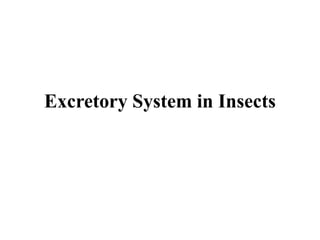
Excretory System.pptx
- 1. Excretory System in Insects
- 2. EXCRETION The removal of waste products of metabolism, especially nitrogenous compounds from the body of insects is known as excretion The excretion process helps the insect to maintain salt water balance and thereby physiological homeostasis The organs of excretion in insects are: I. The Malpighian tubules II. The accessory organs of excretion are: Fat bodies Nephrocytes Oenocytes Labial glands Urate cells The rectum Chloride cells
- 5. Malpighian tubules Malpighian tubules are thin, blind-ending tubules, originating near the junction of mid and hindgut, predominantly involved in regulation of salt, water and nitrogenous waste excretion This structure was discovered by Marcello Malpighi in 1669 These are the main excretory organs in insects These are fine, unbranched and thread-like processes or the outgrowth of alimentary canal and present at the junction of midgut and hindgut They range in length, in different insect species, from 2 to 100 mm and from 30 to 100 μm in diameter In most insects, they open independently into the gut, but in some species they first come together in groups at ampullae In crickets, all the tubules open into a single ampulla from which a cuticle-lined, tubular ureter connects with the hindgut at the posterior end of the ileum
- 7. Malpighian tubules are absent in Collembola and aphids, and represented only by papillae in Diplura, Protura and Strepsiptera, but are present in all other insects, varying in number from two in coccids to about 250 in the desert locust, Schistocerca In adult Periplaneta, with more than 150 tubules, the total outer surface area of the tubules (not taking account of the infolding of the basal plasma membrane) is over 500 mm2, the infoldings increase the surface area at least ten times to more than 5000 mm2 The walls of Malpighian tubule consists of 4-6 large epithelial cells arranged in a circle which externally rests on the basement membrane It is divided into two parts: 1. Distal secretory part having honey comb border 2. Proximal absorptive part having brush border
- 8. The wall of the tubule is one cell thick with one or a few cells encircling the lumen The principal cell type in the tubule is produced into close-packed microvilli on the lumen side, while the basal plasma membrane is deeply infolded Laterally, the cells are held together by septate junctions near their apices Mitochondria are abundant within and immediately beneath the microvilli and in association with the basal plasma membrane These are the cells which produce the primary urine In many insects, cells that are structurally and functionally of different types may be intermingled with the principal cells throughout the tubules, or occur in discrete regions so that the tubule is divided into distinct sections The Diptera, for example, have small stellate cells scattered amongst the principal tubule cells They have small microvilli which do not contain mitochondria. Mixtures of cell types are also known to occur in Periplaneta, Carausius and Tenebrio
- 9. Malpighian tubule (a) Cross-section of a tubule (b) Detail of part of one cell (c) End of a Malpighian tubule of Apis showing the spiral muscle strands and the tracheal supply
- 11. Types of Malpighian Tubules I. Nephridial Malpighian Tubules II. Cryptonephridial Malpighian Tubules I. Nephridial Malpighian Tubules: In large number of insects the distal ends of malpighian tubules bath freely in the haemolymph This arrangement of malpighian tubules are present in insects which do not require conservation of water
- 12. 2. Cryptonephric Malpighian Tubules: The distal ends of the Malpighian tubules are held in contact with the rectal wall by the perinephric membrane, which is concerned either with efficient dehydration of faeces before their elimination or ionic regulation. (e.g. Adult Coleptera, larval Lepidoptera and larval symphyta)
- 13. The accessory organs of excretion Nephrocytes The nephrocytes consist of certain localized groups of cells, often binucleate, which have the property of storing up substances of an excretory nature They occur in two principal groups: (I) Dorsal or pericardial nephrocytes (II) Ventral nephrocytes
- 14. Urate Cells In some insects, certain cells called urate cells are found scattered among the fat body. These highly specialized cells store uric acid during the life of the insect. As the insect grows older, these cells become increasingly loaded with uric acid concentrations. Are found in Collembola (lack Malpighian tubules), Thysanura, Blattodea and larval Apocrita (bees and wasps). Contain large spherules of uric acid. Probably for storage, which is based on some aspect of the insects life cycle or development. Cockroaches do not excrete uric acid. Instead, they store it in the urate cells.
- 15. Fat Bodies A loose or compact aggregation of cells, mostly trophocytes, suspended in the haemocoel, responsible for storage and excretion. Oenocytes The cells of haemocoel, epidermis or fat body with many functions. Integument The outer covering of the living tissues of an insect. Tracheal system The insect gas exchange system, comprising tracheae and tracheoles. Rectum The posterior part of hind gut. Among the above organs, malpighian tubules are the major organ of excretion.
- 16. Storage Excretion The excretory waste materials are retained within the body in different sites. Uric acid is stored as urates in the cells of fat body e.g., American cockroach. Uric acid is stored in the body wall, giving white colour, e.g., Red cotton bug. Uric acid is stored in the male accessory glands to produce the outer coat of spermatophore, which is excreted during copulation. Uric acid is stored in the wing scales giving white colour. e.g., Pierid butterflies. Waste products of pupal metabolism (meconium) is stored and released during adult emergence.
- 17. Thank U